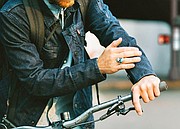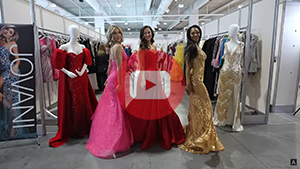TECHNOLOGY
Is ‘Smart Clothing’ Set to Supercharge the Fashion Industry?
Fashion can be forgiving … sometimes. Forget fiddly watches, wireless earbuds that don’t stay put and unattractive virtual-reality glasses. “Smart clothing” is set to supercharge the fashion industry. Strap in for the ride as smart clothing is the next generation of apparel that goes beyond wearables and will change our lives forever.
Traditional wearables have evolved significantly in recent years, so this new breed of technology is much more than just monitoring how many steps you’ve taken or your heart rate. The big difference between smart clothing and traditional apparel is integrated technology such as sensors that are embedded into the fabric to “read” your body. Smart clothes can connect you to technology from head to toe and enable everything from paying for your morning joe and playing music to mapping travel routes, measuring biometrics and even monitoring your emotions. All of this and more—including bras that automatically adjust support under different situations—can be done today without touching or tapping your phone or a screen.
The concept of connected clothing requires e-textiles, e-threads and sensors to make it a reality. France-based Primo 1 D’s ultra-high-frequency RFID yarn enables the embedding of RFID tags directly into fabrics. The e-thread is an RFID yarn with the antenna built into the yarn strand, which allows for a truly invisible, inseparable and immutable integration of material and fabric. U.K.-based Advanced E-Textiles is making thread-sized microelectronic tags that are washable and can simply be sewn right into a garment and then be read by RFID. Most consumers would be unable to detect the tiny tags when wearing the garment.
Other traditional RFID providers and startups alike are creating progressive technologies, platforms and apps utilizing the power of tinier and more-functional sensors. Companies such as Los Angeles−based Mojix, Seattle-based Impinj and New Jersey−based Checkpoint Systems are all working closely with brands, retailers and manufacturers to help drive new customer engagements and experiences. Luxury brands have been quicker to embrace these new technologies because of the associated costs, but, as manufacturing costs go down, the usage will increase for every segment of the apparel industry over the next 24 months.
Let’s take a look at a few fashion brands that are leading the smart way:
• Google and Levi’s Trucker Jacket With Smart Touch
What happens when 150 years of Levi’s denim innovation meets Google engineering? A groundbreaking garment called Levi’s Commuter Trucker Jacket. The end of the left sleeve is made of a slightly different denim material that’s been specially woven with conductive Touch-sensitive Jacquard Thread, which allows the sleeve to act as an interactive touchpad for the jacket. The jacket connects to a mobile device via Bluetooth technology. With a tap or brush of the sleeve cuff, you can control music, screen phone calls, get directions and more. A few simple gestures keep you on course and in touch.
• SUPA-Powered Smarter Sports Bra
The New York−based artificial-intelligence startup SUPA was founded by Sabine Seymour, a fashion tech expert and director of the Fashionable Technology Lab in partnership with the Parsons School of Design. SUPA, which has a new application using smart sensors, is a secure biometric data platform that contextualizes data derived from distributed IoT (Internet of Things) devices that monitor nutrition, heart rate, motion and temperature. These Movesense sensors can be integrated into apparel, including SUPA’s newly equipped sports bras, which can be worn underwater as well as in extreme weather conditions.
• Nadi X Vibrating and Virtual Yoga Pants
The Sydney-based startup Wearable X’s Nadi X pants have woven-in technology with sensors that provide gentle vibrations at the hips, knees and ankles to encourage you to move and/or hold positions for an easier yoga workout. The sensors sync up via Bluetooth to your phone and through the companion app, which gives you additional feedback.
• L.L. Bean’s Boots With a Brain
Leading multi-channel merchant of quality outdoor gear and apparel, L.L.Bean has partnered with Loomia, a technology company that adds intelligence to make the manufacturer’s boots and jackets smarter. Loomia manufactures soft, flexible circuitry that can sense and track data while seamlessly integrating with chosen materials. These sensors are washable, dryable, sewable and discreet. Once L.L. Bean embeds this technology into its boots, it will be able to collect information about temperature, motion and frequency of wear. Once this data is collected, consumers will be able to share it back with the brand for rewards via the Loomia Tile—a component that allows for the secure and anonymous transfer of data.
• Under Armour’s Smart Sleepwear and Shoes
Under Armour recently unveiled “smart sleepwear,” which the company claims helps athletes “to rest, win and repeat.” This Athlete Recovery Sleepwear has an infrared pattern inside the clothing to absorb infrared wavelengths and reduce inflammation while an athlete is sleeping, aiding in recovery time. Under Armour has also launched two new pairs of connected running shoes at the Consumer Electronics Show with embedded sensors in the foam soles that can track key statistics such as distance, slide, length and cadence.
Smart clothing presents new avenues for smart retailers and brands to drive greater sales, and it really can supercharge the fashion business. Additionally, with the apparel, footwear and accessories industries having connected devices built into their products, brands can analyze customers’ habits and then optimize marketing outreach. It can also create unique engagements never available before to deliver a better brand experience and a real connection, physically and digitally as well as emotionally.
Jerry Inman is a retail expert focused on the fashion, style and technology industries. He is also the cofounder of the retail consultancy Demand Worldwide as well as of the fashion trend forecaster MintModa.






















